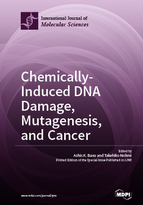Chemically-Induced DNA Damage, Mutagenesis, and Cancer
A special issue of International Journal of Molecular Sciences (ISSN 1422-0067). This special issue belongs to the section "Molecular Toxicology".
Deadline for manuscript submissions: closed (15 October 2017) | Viewed by 125822
Special Issue Editors
Interests: carcinogen-nucleic acid interactions; DNA damage; DNA repair; cross-links in DNA; mechanism of mutation and cancer; chemistry and biology of natural products with antitumor properties
Special Issues, Collections and Topics in MDPI journals
Interests: genotoxicity; DNA damage; mutation; translesion synthesis; DNA repair; DNA polymerase; risk assessment; chemical carcinogens
Special Issue Information
Dear Colleagues,
A large number of chemicals have been associated with the etiology of human cancers. DNA damage induced by a chemical in a cell is an important first step in the process of chemical carcinogenesis. Various DNA repair mechanisms have evolved to take care of the DNA damages, but they cannot repair every single one, especially when the damages are induced at a high frequency. Replication of damaged DNA increases the rate of polymerase errors, resulting in gene mutations, which may lead to the synthesis of altered proteins. Mutations in an oncogene, a tumor-suppressor gene, or a gene that controls the cell cycle can give rise to a clonal cell population with a distinct advantage in proliferation. Many such events, occurring over a long period of time and taking place within the context of chronic exposure to chemical mutagens, can lead to the induction of human cancer. This is exemplified in the long-term use of tobacco being responsible for an increased risk of lung cancer. The aim of this Special Issue is to provide a broad overview on the topic of the “consequence of DNA damage” in the context of human cancer with their challenges and highlights. We ask the experts in the field to contribute their latest research, perspective, or reviews on this fascinating and rapidly progressing topic.
Prof. Dr. Ashis Basu
Guest Editor
Manuscript Submission Information
Manuscripts should be submitted online at www.mdpi.com by registering and logging in to this website. Once you are registered, click here to go to the submission form. Manuscripts can be submitted until the deadline. All submissions that pass pre-check are peer-reviewed. Accepted papers will be published continuously in the journal (as soon as accepted) and will be listed together on the special issue website. Research articles, review articles as well as short communications are invited. For planned papers, a title and short abstract (about 100 words) can be sent to the Editorial Office for announcement on this website.
Submitted manuscripts should not have been published previously, nor be under consideration for publication elsewhere (except conference proceedings papers). All manuscripts are thoroughly refereed through a single-blind peer-review process. A guide for authors and other relevant information for submission of manuscripts is available on the Instructions for Authors page. International Journal of Molecular Sciences is an international peer-reviewed open access semimonthly journal published by MDPI.
Please visit the Instructions for Authors page before submitting a manuscript. There is an Article Processing Charge (APC) for publication in this open access journal. For details about the APC please see here. Submitted papers should be well formatted and use good English. Authors may use MDPI's English editing service prior to publication or during author revisions.
Keywords
- DNA damage
- Carcinogen-DNA adduct
- Genotoxicity
- DNA repair
- Mutation
- Mutagenesis
- Carcinogenesis
- Trans-lesion synthesis
- DNA polymerase








